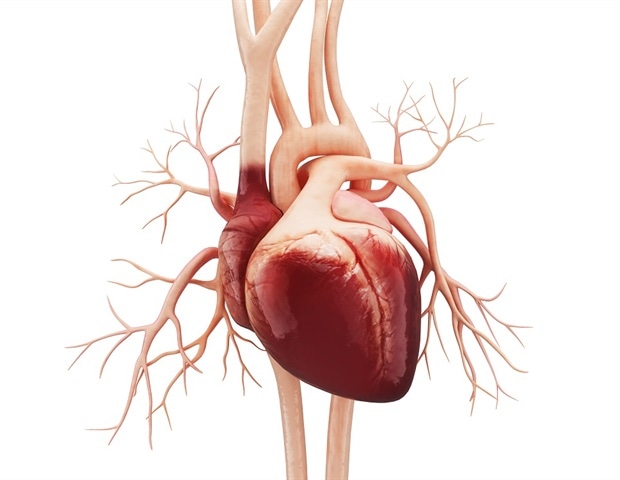A group of Berlin researchers in collaboration with international scientists have found differences in heart inflammation caused by COVID-19, anti-COVID-19 vaccination, and non-COVID-19 myocarditis. The find paves the way for more personalized therapies, they report in “Nature Cardiovascular Research.”
Heart inflammation, or myocarditis, differs depending on its cause. A collaborative study led by Dr. Henrike Maatz, a scientist in the Genetics and Genomics of Cardiovascular Diseases lab of Professor Norbert Hübner at the Max Delbrück Center in Berlin, identified distinct immune signatures in myocarditis caused by SARS-CoV-2 infection and mRNA vaccines compared to non-COVID-19 myocarditis. The study was published in “Nature Cardiovascular Research.”
We found clear differences in immune activation. This knowledge might help to develop new and more personalized therapies that are tailored to specific types of inflammation.”
Dr. Henrike Maatz, co-lead author
A unique opportunity during the pandemic
Myocarditis is caused by various types of infections, autoimmune disorders, genetic and environmental factors, and rarely, vaccination. COVID-19 is primarily a respiratory disease, but it is well known that SARS-CoV-2 infection can injure the heart. In children and young adults, SARS-CoV-2-infection can cause multisystem inflammatory syndrome, with myocarditis being the most prevalent clinical feature, although this is rare.
When the coronavirus pandemic hit, researchers at the Max Delbrück Center, the Berlin Institute of Health at Charité (BIH) and Charité – Universitätsmedizin Berlin saw a unique opportunity to study whether myocarditis differs on a cellular and molecular level depending on the cause.
The Hübner lab has long had an interest in studying cardiac disease at the single-cell level. They teamed up with Professor Carsten Tschöpe, a cardiologist at the Deutsches Herzzentrum der Charité (DHZC), head of the BIH research group for Immunocardiology and principal investigator at Deutsches Zentrum für Herz-Kreislauf-Forschung(DZHK). His team had been collecting biopsy samples from patients presenting with suspected myocarditis. “At the DHZC, we have a widely recognized Myocarditis Unit, specializing in performing endomyocardial biopsies in selected cases,” says Tschöpe.
“The study program, which was initiated by Charité during the COVID-19 crisis, was integrated into the curriculum and forms part of the PERSONIFY- Program supported by the DZHK. Within this framework, patients with myocarditis undergo highly specific and targeted investigations, ensuring a comprehensive and advanced approach to their clinical and scientific evaluation.”
“We are deeply grateful to the patients for their trust and invaluable contributions and to our specialist heart failure nurses for their essential role in identifying patients, ensuring meticulous data management, careful tissue and blood handling, and overall patient care,” Tschöpe adds.
Distinct immune activation
Researchers at the Max Delbrück Center performed single-nucleus RNA sequencing (snRNA-seq) on biopsied heart tissue to study gene expression and to create transcriptional profiles of each cell. These profiles served to identify the different cell types of the heart. They examined the molecular changes in each cell, and the abundance of the different cell types in three different sets of myocarditis tissue: COVID-19 positive samples, cases caused by mRNA vaccines, and non-COVID-19 heart inflammation caused by viral infections before the pandemic.
They found that while some gene expression changes were similar across the three groups, there were significant differences in levels of immune cell gene expression. What’s more, transcriptional profiles also showed that immune cells differed in abundance, depending on the cause of the myocarditis.
“Such differences were unexpected,” says Dr. Eric Lindberg, co-lead author of the paper, former postdoc in the Hübner lab, who now heads a research group at the LMU hospital in Munich. The researchers for example found that post-vaccination, CD4 T-cells were more abundant whereas post SARS-CoV-2 infection, CD8 T cells tended to be more dominant. In the non-COVID-19 myocarditis samples, the CD4 to CD8 cell ratio was about 50/50, he adds. Gene expression data suggested that the CD8 T cells in the post-COVID-19 group also appeared to be more aggressive than in non-COVID myocarditis. The researchers also found a small population of T cells present in post-COVID-19 myocarditis that have previously only been observed in the blood of severely sick COVID-19 patients.
“Together, these findings suggest a stronger immune response in post-COVID-19 myocarditis compared to pre-pandemic forms of myocarditis, while the myocardial inflammation appeared to be milder in post-vaccination,” says Professor Norbert Hübner of the Max Delbrück Center and Charite – Universitätsmedizin Berlin, corresponding author on the paper and a principal investigator at the DZHK. Although the sample size from patients with post-vaccination myocarditis was small, the results are in line with other studies of post-vaccination myocarditis, Hübner adds.
Implications for treatment
Being able to differentiate between inflammation caused by different kinds of infections and vaccination paves the way to improve treatment tailored to specific types of inflammation, says Maatz. Based on the research, one could develop new therapies to control the side effects from vaccines, for example, she adds.
Also, biopsy samples of the heart are generally tiny – they are no larger than a pin head. It was a challenge to get the snRNA-seq technique to work using such minute amounts of tissue, Maatz says. “But I think the resolution and depth of insight we were able to generate really shows the power of this method – perhaps in the future also in a diagnostic setting.”
Source:
Max Delbrück Center for Molecular Medicine in the Helmholtz Association
Journal reference:
Maatz, H., et al. (2025). The cellular and molecular cardiac tissue responses in human inflammatory cardiomyopathies after SARS-CoV-2 infection and COVID-19 vaccination. Nature Cardiovascular Research. doi.org/10.1038/s44161-025-00612-6.
Read the full article here


